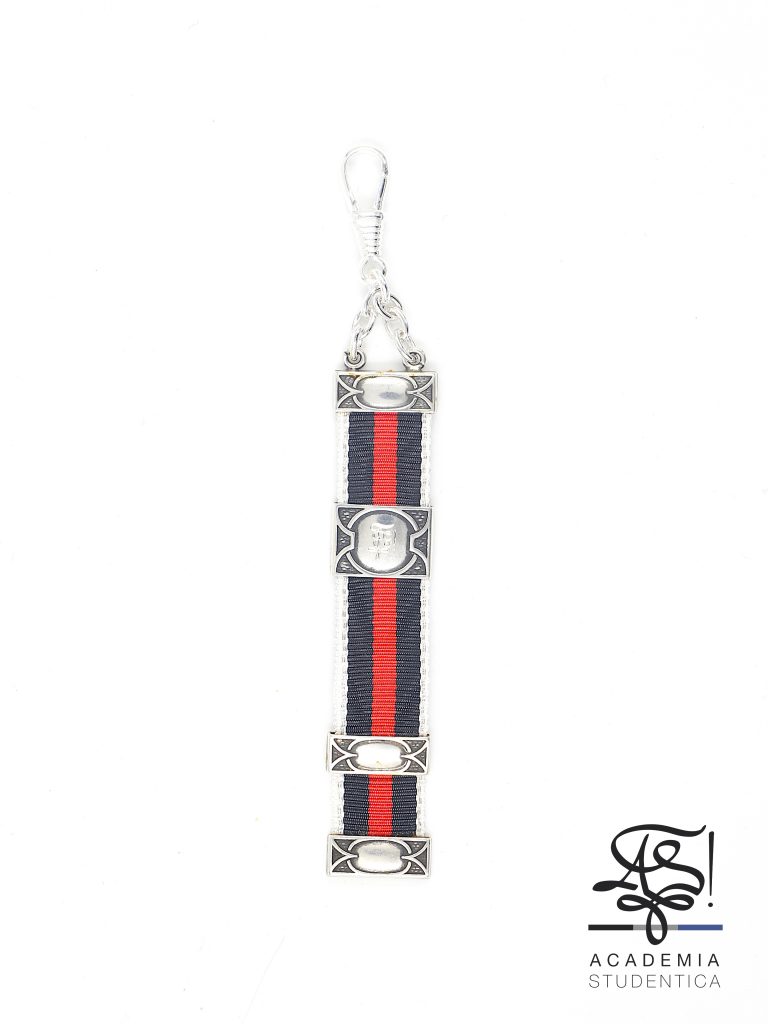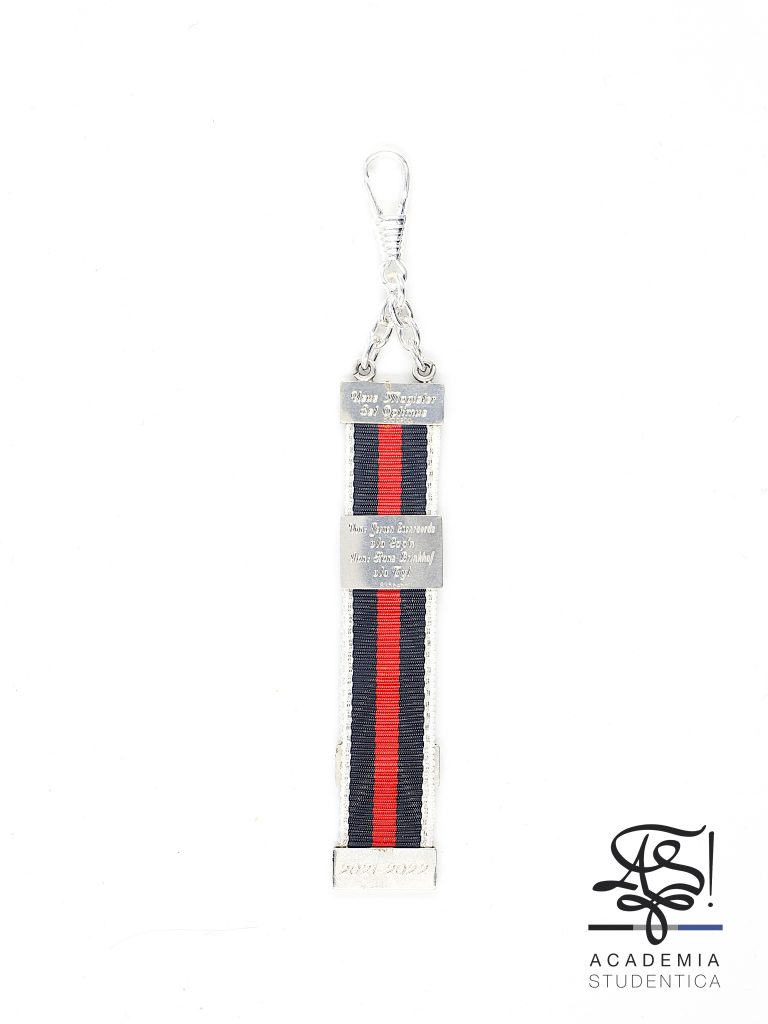Weinzipfel, Geronticos, Belgium, Leuven, 2022.
Coll.: Tyl
Zipfels are charms made out of two pieces of band of different lengths, finished with metal plates. They are attached to a so-called « Zipfelhalter » (tr.: Zipfel holder), which is clipped onto the belt or the pocket of a jacket.
Usually there’s a small plate on top with two small chains connected to a little hook, with which one can hang the Zipfel from the Zipfel holder. In this plate both bands are secured. The front band is the shortest of the two. Both bands are held together by the so-called «Schieber»; the most obvious central plate. On its front side, usually the weapon, mascotte or Zirkel is engraved. On the backside the names of the exchanging parties are engraved. Both bands are decorated with a metal plate on each end. When members of two different societies exchange Zipfels, the front band sports the colors of the giving party, while the rear band is in the colors of the receiving party.
The Zipfel came into fashion during the 19th century. Concerning its origins several theories exist.
The first theory claims that they were conceived as an answer to the Karlsbad Decrees. These were a series of measures to suppress national-liberal tendencies within the German Confederation. The decrees came into being during the Karlsbad Congresses (6-31 August 1819) and were accepted on 20 September 1819 by the urging of Austria and Prussia. These decrees were implemented because of the murder by radical «Burschenschafter» (member of a student corporation) Karl Ludwig Sand of playwright August von Kotzebue, who in his «Literarisches Wochenblatt» mocked patriotic German students. These decrees resulted among others in a ban on student societies. The societies went underground and their members would keep small pieces of band in their pocket to make themselves known to the like-minded.
Another theory claims the Zipfel was attached to one’s beerglass (a habit still in use today) to recognize one’s own glass.
Other sources assume that the Zipfel is derived from the chatelaine. A chatelaine was originally a kind of girdle carried around the waist, on which several daily utensils, also called tackles, were attached. Besides its practical use, chatelaines were also worn as jewelry or as a symbol of an engagement. The use of chatelaines was less common with men, because men’s fashion usually came equipped with pockets. By the end of the eighteenth century, they began hanging several objects from their pocket watches, such as watch-keys, signets and several charms regarding occupation.
Most likely all three elements played their part in the origins of the Zipfel.
This particular Zipfel is a Weinzipf. They are made out of 2 pieces of Weinband (13 mm wide). These Zipfels are the most common kind, and are exchanged among commilitones, or given to their godfather/-mother by first year students.
Geronticos was founded 13 May 2013 by Hans Brinkhof v/o Tyl.
Their colors are black-red-black. Their shield is black with a red band running from the top right to the bottom left. It is divided by a grey 8-pointed cross with the shield of Leuven at its center (red-white-red). The top left shows Apollo’s lyre, a songbook, a student cap and a full glass of beer. The topright field shows the monogram. The bottom right field depicts a hammer, club and sword with roman numerals referring to the founding date. The bottom left field shows three connected rings standing for the three pillars of Geronticos.
Geronticos is a Leuven student association that unites the old members of Gaudia.
More info:
Weinzipfel, Geronticos, Belgique, Louvain, 2022.
Coll.: Tyl
Les zipfels sont des breloques faites de deux morceaux de band de longueurs différentes, terminés par des plaques en métal. Elles sont attachées à un «Zipfelhalter» (tr. : porte-zipfel), qui est accroché à la ceinture ou à la poche d’une veste.
Habituellement, il y a une petite plaque sur le dessus avec deux petites chaînes reliées à un petit crochet, avec lequel on peut accrocher le Zipfel au porte-zipfel. Dans cette plaque, les deux band sont fixés. Le band avant est le plus court des deux. Les deux band sont maintenus ensemble par le «Schieber», la plaque centrale la plus visible. Sur sa face avant, l’armoirie, la mascotte ou le Zirkel sont généralement gravés. Au dos, les noms des personnes qui l’échangent sont gravés. Les deux band sont décorés d’une plaque en métal à chaque extrémité. Lorsque des membres de deux sociétés différentes échangent des Zipfels, le band avant porte les couleurs de la personne qui donne, tandis que le band arrière est aux couleurs de la personne qui reçoit.
La Zipfel est à la mode depuis le XIXe siècle. En ce qui concerne ses origines, plusieurs théories existent.
La première théorie prétend qu’ils ont été conçus comme une réponse aux décrets de Karlsbad. Il s’agissait d’une série de mesures visant à supprimer les tendances nationales-libérales au sein de la Confédération allemande. Les décrets ont vu le jour lors des congrès de Karlsbad (6-31 août 1819) et ont été acceptés le 20 septembre 1819 à l’instigation de l’Autriche et de la Prusse. Ces décrets ont été mis en œuvre en raison du meurtre par le «Burschenschafter» radical (membre d’une corporation d’étudiants) Karl Ludwig Sand du dramaturge August von Kotzebue, qui dans son «Literarisches Wochenblatt» se moquait des étudiants allemands patriotes. Ces décrets ont notamment entraîné l’interdiction des sociétés étudiantes. Les sociétés sont devenues clandestines et leurs membres gardaient de petits morceaux de band dans leur poche pour se faire connaître des personnes partageant les mêmes idées.
Selon une autre théorie, le Zipfel était attaché à son verre de bière (une habitude encore en vigueur aujourd’hui) pour reconnaître son propre verre.
D’autres sources supposent que le Zipfel est dérivé de la châtelaine. Une châtelaine était à l’origine une sorte de gaine portée autour de la taille, sur laquelle étaient fixés plusieurs ustensiles quotidiens. Outre son usage pratique, la châtelaine était également portée comme bijou ou comme symbole d’un engagement. L’utilisation des châtelaines était moins courante chez les hommes, car la mode masculine était généralement équipée de poches. À la fin du XVIIIe siècle, ils ont commencé à accrocher plusieurs objets à leur montre de poche, comme des clés, des signets et plusieurs breloques concernant l’occupation.
Ces trois éléments ont très probablement joué un rôle dans les origines du Zipfel.
Ce Zipfel particulier est un Weinzipf. Ils sont composés de deux pièces de Weinband (13 mm de large). Ces Zipfels sont les plus courants, et sont échangés entre commilitones, ou donnés à leur parrain/mère par les étudiants de première année.
Geronticos a été fondée le 13 mai 2018 par Hans Brinkhof v/o Tyl.
Leurs couleurs sont noir-rouge-noir. Leur blason est noir avec une bande rouge allant du haut à droite au bas à gauche. Il est divisé par une croix grise à huit pointes avec l’écu de Louvain en son centre (rouge-blanc-rouge). En haut à gauche, on peut voir la lyre d’Apollon, un chansonnier, une casquette d’étudiant et une chôpe. Le champ en haut à droite montre le monogramme. Le champ inférieur droit montre un marteau, une massue et une épée avec des chiffres romains se référant à la date de fondation. Le champ inférieur gauche montre trois anneaux reliés entre eux qui représentent les trois piliers de Géronticos.
Geronticos est une association d’étudiants de Louvain qui réunit les anciens membres de Gaudia.
Plus d’infos :
Weinzipfel, Geronticos, Leuven, 2022.
Coll.: Tyl
Zipfels zijn hangers gemaakt uit twee stukken band van verschillende lengte, afgewerkt met metalen plaatjes. Ze worden bevestigd aan een zogenaamde «Zipfelhalter» (tr.: Zipfelhouder), die aan de riem of de zak van een jasje wordt geklemd.
Meestal zit er bovenaan een plaatje met twee kleine kettinkjes die verbonden zijn met een haakje, waarmee men de Zipfel aan de Zipfelhouder kan hangen. In dit plaatje zijn beide banden bevestigd. De voorste band is de kortste van de twee. Beide banden worden bijeengehouden door de zogenaamde «Schieber»; de meest opvallende middenste plaat. Op de voorkant ervan is meestal het wapen, de mascotte of de Zirkel gegraveerd. Op de achterzijde zijn de namen van de uitwisselende partijen gegraveerd. Beide banden zijn versierd met een metalen plaatje aan elk uiteinde. Wanneer leden van twee verschillende verenigingen Zipfels uitwisselen, draagt de voorste band de kleuren van de gevende partij, terwijl de achterste band in de kleuren van de ontvangende partij is.
De Zipfel kwam in de 19de eeuw in de mode. Over de oorsprong ervan bestaan verschillende theorieën.
De eerste theorie beweert dat ze werden ontworpen als antwoord op de Decreten van Karlsbad. Dit waren een reeks maatregelen om nationaal-liberale tendensen binnen de Duitse Confederatie te onderdrukken. De decreten kwamen tot stand tijdens de Congressen van Karlsbad (6-31 augustus 1819) en werden op 20 september 1819 aanvaard op aandringen van Oostenrijk en Pruisen. Deze decreten werden ingevoerd naar aanleiding van de moord door de radicale «Burschenschafter» (lid van een studentenvereniging) Karl Ludwig Sand op toneelschrijver August von Kotzebue, die in zijn «Literarisches Wochenblatt» de spot dreef met patriottische Duitse studenten. Deze decreten leidden onder meer tot een verbod op studentenverenigingen. De verenigingen gingen ondergronds en hun leden hielden kleine stukjes band in hun zak om zich kenbaar te maken bij gelijkgestemden.
Een andere theorie beweert dat de Zipfel aan het bierglas werd bevestigd (een gewoonte die vandaag de dag nog steeds in gebruik is) om het eigen glas te herkennen.
Andere bronnen gaan ervan uit dat de Zipfel is afgeleid van de chatelaine. Een chatelaine was oorspronkelijk een soort gordel die om het middel werd gedragen en waaraan verschillende dagelijkse gebruiksvoorwerpen, ook wel tuigjes genoemd, werden bevestigd. Naast het praktische gebruik werden chatelaines ook gedragen als sieraad of als symbool van een verloving. Het gebruik van chatelaines was minder gebruikelijk bij mannen, omdat herenmode meestal was uitgerust met zakken. Tegen het einde van de achttiende eeuw begonnen zij verschillende voorwerpen aan hun zakhorloge te hangen, zoals horlogesleutels, symbolen en verschillende bedeltjes met betrekking tot het beroep.
Waarschijnlijk hebben alle drie elementen een rol gespeeld bij het ontstaan van de Zipfel.
Deze specifieke Zipfel is een Weinzipf. Ze zijn gemaakt van 2 stukjes Weinband (13 mm breed). Deze Zipfels zijn de meest voorkomende soort, en worden uitgewisseld tussen commilitones, of aan hun peter/meter gegeven door eerstejaars studenten.
Geronticos werd op 13 mei 2018 opgericht door Hans Brinkhof v/o Tyl.
Hun kleuren zijn zwart-rood-zwart. Hun schild is zwart met een rode band die van rechtsboven naar linksonder loopt. Het wordt gedeeld door een grijs 8-puntig kruis met het schild van Leuven in het midden (rood-wit-rood). Linksboven staan de lier van Apollo, een zangboek, een studentenpet en een vol glas bier. Rechtsboven staat het monogram. Rechtsonder staan een hamer, knuppel en zwaard met Romeinse cijfers die verwijzen naar de stichtingsdatum. In het veld linksonder staan drie met elkaar verbonden ringen voor de drie zuilen van Geronticos.
Geronticos is een Leuvense studentenvereniging die de oud-leden van Gaudia verenigt.
Meer info:

